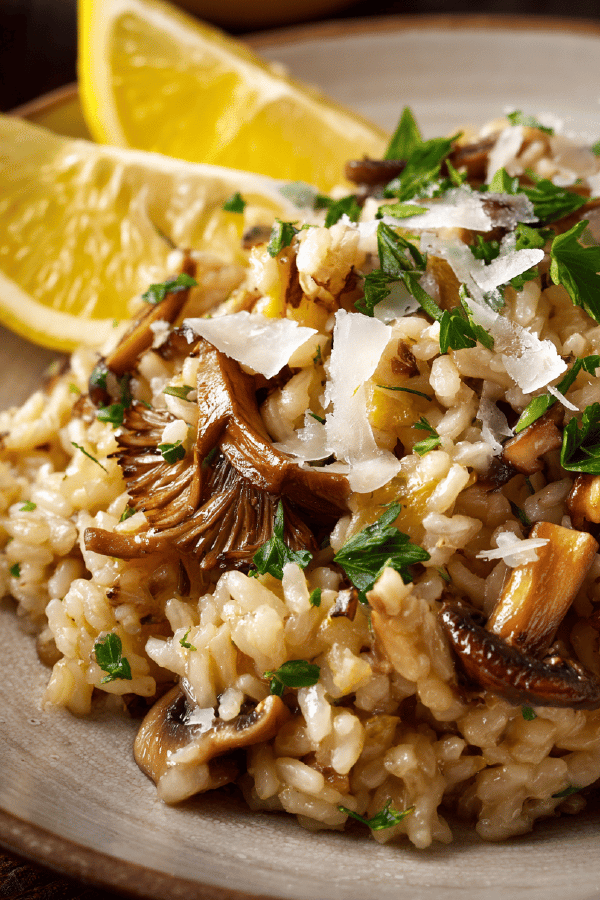Featured Recipe
Wild Mushroom Risotto Twist

By Kate
"
A rustic risotto relying on porcini instead of bolets, chicken broth swapped for vegetable stock, and cremini mushrooms added to the usual whites. Garlic softened gently to avoid bitterness and shallots sweated until translucent but not browned. Wine reduced carefully to near dryness for brightness. Five-minute variance on cooking times. Parmesan swapped with pecorino for sharper tang. Finished with a squeeze of fresh lemon juice to lift the earthy, buttery depths. Technique focused on layering flavors with proper evaporation and absorption stages to avoid mush. Watch texture not time.
"
Prep:
25 min
Cook:
45 min
Total:
Serves:
4 servings
risotto
vegetarian
comfort food
Italian cuisine
Introduction
Risotto’s about patience, watching textures and smells. Not microwaving rice till mush but coaxing starch out gradually. Incorporate mushrooms in two forms—dried porcini steeped in stock and fresh cremini in butter. This double hit layers flavor without overpowering. Butter gloss gives that velvety feel; acid from wine and lemon lifts it. Don’t rush or skip steps; low and slow browns shallots and mushrooms differently than hurrying them to color. You’ll hear the sizzle quiet down then that faint pop as moisture escapes before aroma fills the kitchen—wonderful signal you’re on track. Cheese melted in at the end brings everything together without clumping. Expect a risotto that spreads but isn’t soupy, bite with chew but not crunch. All about balance.
Ingredients
About the ingredients
Porcini mushrooms bring deep umami and forest notes—a great swap for bolets dried mushrooms. Fresh cremini balance texture and body better than just whites; they have earthier tones and hold shape longer. Butter divided ensures mushrooms cook without burning then enrich shallots and rice later. Pecorino sharper than Parmesan, cut the richness; you can swap for aged Grana Padano or even a blend of Parmesan and Asiago. Use vegetable stock if looking vegetarian or lighter flavor. Avoid rinsing rice—just toast. Wine you want dry and crisp, no sweet Riesling; Sauvignon Blanc is a good option. Lemon juice last moment brightens flavors, prevents monotony in heavy dishes. Garlic smaller in amount and finely minced prevents harsh bites. If no porcini, substitute shiitake dried mushrooms. Cheese worries? Nutritional yeast sprinkled at end adds cheesy umami but no dairy.
Method
Technique Tips
Start infusing stock early with porcini for max flavor extraction—skip tossing mushroom water into stock; grit spoils texture. Sauté mushrooms first so their water fully evaporates and browning initiates Maillard reaction; texture differs vastly if mushrooms steamed instead of sautéed—no color, bland mousse layer. Keep butter controlled; too much, greasy, too little, stick or burn. Shallots sweat low and slow, translucent, this unlocks sweetness without bitterness. Toast rice grains to envelop starch with butter; this step prevents clumping and ensures each rice grain swells neatly. Wine reduction—watch bubbling sound shift, smell acidity and aftertaste; reduces alcohol flavor and intensifies. Adding hot stock steadily and stirring frequently activates starch release, critical for that creamy mouthfeel. Don’t dump too fast or risk uneven cooking or mush. Doneness judged by bite test—chewy core, creamy outside. Resting lets grains relax and marry flavors. Vigorous final stirring melts cheese evenly; lukewarm risotto is ideal—not hot or cold. Lemon at the end is a rarely used trick—cuts heaviness and refreshes palate. Serve immediately; risotto thickens and becomes pasty with cooling. Leftovers? Transform next-day risotto into cakes fried crisp for second life.
Chef's Notes
- 💡 Start with porcini in stock early for max flavor. Gently toast shallots and mushrooms. Smell and sound tell when ready. Skipping proper steps leads to bland.
- 💡 Avoid water for porcini stock—gritty ruins. Sauté mushrooms—get them browned. No steam, just flavor. Add butter slowly, too little burns, too much makes soggy.
- 💡 Watch rice texture; glossy but not mushy. Stir constantly while adding stock—increase absorption. Creaminess comes from releasing starch. Not just about timing.
- 💡 Season salt carefully—pecorino is salty. Gritty shallots can bitter flavors; keeping them translucent works. Rest risotto—let flavors marry before serving.
- 💡 Last minute squeeze of lemon, critical. Brighten butteriness with acidity. Don’t let risotto sit too long—it thickens and pastes fast. Serve gently spread—not heaped.
Kitchen Wisdom
What if my risotto is too dry?
Add hot stock bit by bit. Stir. If it clumps, don’t panic. Keep adding moisture till creamy.
Can I use other mushrooms?
Yes, shiitake works. Or use mixed fresh ones for variety. Texture matters—fresh mushrooms should hold shape.
Leftover risotto tech?
Form into cakes, pan-fry for crispness next day. Or warm gently with broth. Creamy again but a different dish.
Storage options for risotto?
Store in fridge, airtight. It’s better fresh but can manage a few days. Reheat with broth to keep creamy.



